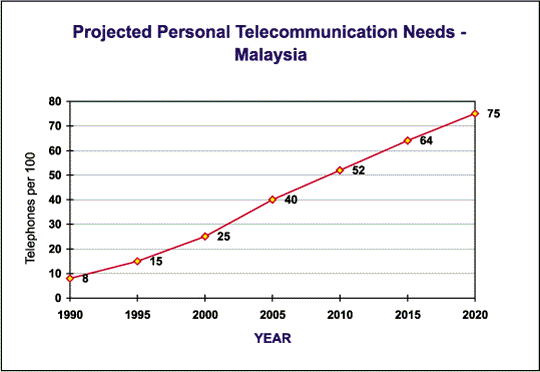3.1 Telecommunications Infrastructure
In order for the NIG to be accessible to as many parties as possible, the
countryís telecommunications infrastructure must exist with sufficient
delivery capacity to reach the target users.
From a single state-owned telephone company in the 1980ís, the number of telcos have now increased into several private-sector corporations as listed below. As mentioned in The NIG Concept chapter, several telcos (instead of one) will provide resilience and survivability of the physical grid:
|
|

Figure 3-1. Projected increase of telephones
in Malaysia
Fibre-optic trunks are being laid and licenses have been issued for the latest wireless communications standards, satellite operations and more land-based lines that also includes the recent introductions of narrowband ISDN technology to facilitate public electronic data transportation (public data networks).
The major reason for this rapid expansion, both in volume and technology, is to elevate the local infrastructure into that of developed nationís. Currently, the estimated number of telephones for every 100 persons in Malaysia is 15. Developed countries like Germany and USA have over 70 telephones per 100 people. Figure 3-1 shows the projected rate of increase Malaysia is making in order to achieve that ratio by the year 2020.
In addition to geographical and demographical coverage, the telcos have begun to implement data communication services that support future information interchange protocols and needs. Celcom officially launched their wireless data service in March 1995 and Telekom Malaysia, the local giant, is planning and implementing several networks and services that will support the NIG strategy (see Figure 3-2).

Figure 3-2. STMBís Network Strategy services
and planned implementation. Source: Malaysian Industry (April 1995 issue)
and Jabatan Telekom Malaysia.
An additional factor in increasing access to the NIG is the television industry. The number of television-to-person ratio in Malaysia is also increasing, following the steady rise in per capita income. The planned cable- and pay-TV services will enable on-demand information delivery and interactivity to be implemented. These factors, in addition to the telecommunications expansion, will further increase the development of the NIGís physical component.
